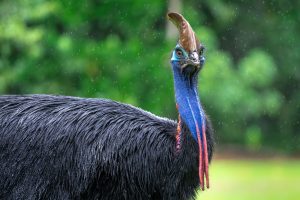Biology & Physiology
The Southern Cassowary from top to toe
Southern Cassowaries can grow as large and heavy as humans! Adult Cassowaries are typically between 1.5-1.8 metres tall and females can weigh up to 70 kilograms. Adult females are larger than males (males rarely exceed 50 kilograms), and males have a slightly drooping tail.
Casque
One of the Cassowary’s most defining features is its casque, the helmet-like structure on its head. Duck-billed dinosaurs that roamed the earth 65 million years ago (e.g. corythosaurus and parasaurolophus) had similar ‘wedged’ heads.
Each casque is unique often showing signs of permanent damage from accidents and injuries. Absent in Cassowary chicks, the casque begins growing in juveniles when their plumage changes from striped to brown. The casque is pliable and has a bony or calcified frame covered in keratin, the same protein found in horse hoofs, reptile scales, bird beaks, claws and feathers; and human hair and nails.
Inside, the casque is spongy and contains many tiny blood vessels. They are thought to be used in communication, as an amplifier or receiver of the birds’ low-frequency infrasound vocalisations. There may also be a heat dispersal function during hotter weather.
Voice
Cassowaries communicate with each other through a range of hissing, rumbling, coughing and booming noises. The main purposes of these noises are (probably) to: attract and court a mate during the breeding season; warn other Cassowaries of their presence; and assist communication between fathers and chicks. (Like most young birds, Cassowary chicks ‘chirp’ or ‘whistle’ to communicate with their parents).
The low-frequency, booming calls of the Southern Cassowary are at the bottom end of human hearing. At 32 Hertz, they are the lowest known vocalisations of all birds and have been described as ‘strange’ and ‘unsettling’ by people who have heard them. These low-frequency sounds (known as ‘infrasound’) are thought to travel over long distances, even through dense rainforest foliage. Elephants and emus also communicate via infrasound.
Cassowary Calls
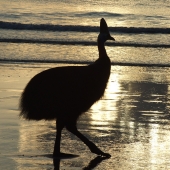


Beak and Mouth
Cassowaries have pointed beaks and do not have tongues. They must pick up and toss food with their beaks, to the back of their throats before swallowing. Cassowaries prefer fallen fruits but have been observed eating low-hanging fruits from shrubs and trees. When drinking, they scoop up water with their lower bill.
Neck and Wattle
The Southern Cassowary’s featherless neck is brightly coloured in blues, reds and purples, which can be more vivid in females during the breeding season. The colour becomes more intense when Cassowaries become excited such as during mating. The wattles are not known to have a function, but vary greatly in size and colour between individual birds and have been used to differentiate between adult birds.
Feathers and Wings
Southern Cassowaries have glossy, black, double-shafted feathers.
Although they can’t fly, they have small vestigial wings that are hidden from sight by the feathers — apart from 5 or 6 long, hardened feather quills. Cassowaries have a claw on the second digit of their wings, which is unusual, as claws on other birds are usually on the first digit.
Feet
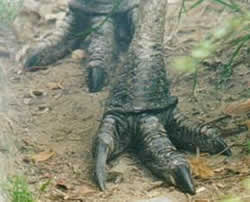 As Southern Cassowaries spend their lives on the ground, they have muscular legs and large, powerful feet that allow them to move quickly through the rainforest.
As Southern Cassowaries spend their lives on the ground, they have muscular legs and large, powerful feet that allow them to move quickly through the rainforest.
Cassowaries have three-toed feet with sharp claws. The inner toe sports a dagger-like claw that can be up to 12.5 cm (4.9 in) long. These are sometimes used in self-defence or to protect their young.
Breeding and Raising Young
Ladies’ Choice
Southern Cassowaries generally breed during the dry season (May-October). The females are usually dominant but are tolerant of males during this time. The female selects a mate with whom she may spend days or even weeks, during which the male will ‘court’ his partner through dance, display and vocalising.
Every day is Father’s Day!
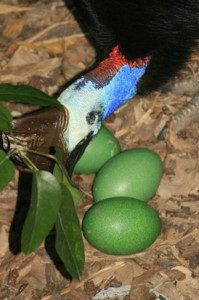 The female usually lays about 4 eggs. The male then takes sole responsibility to incubate them for about 50 days, during which time he hardly eats. After hatching, he cares for the chicks for about 9 months and often longer if he doesn’t mate in the following season.
The female usually lays about 4 eggs. The male then takes sole responsibility to incubate them for about 50 days, during which time he hardly eats. After hatching, he cares for the chicks for about 9 months and often longer if he doesn’t mate in the following season.
Cassowary fathers are very protective of their eggs and chicks and may become aggressive in their defence.
Females may mate with more than one male during each season and are sometimes seen hanging out with family groups.
Chick
Chicks hatch with brown and cream striped plumage, perfect camouflage for their sun-dappled habitat. The biology & physiology of chicks is different in that they do not yet have a casque and their wattles are very small and cream coloured. Chicks are totally dependent on their father for food and protection.
Juvenile
At 4- 5 months of age chicks begin to lose their stripes, which are replaced by longer brown feathers, similar to the black plumage of adult birds. In juvenile birds, the wattle begins to grow slowly and turn a pale pink colour, and the casque begins to grow. Juvenile birds are still in Dad’s care but begin to forage and explore independently or with their siblings.
Sub-adult
Juvenile birds are said to be sub-adult when they become independent of their father, which normally occurs when they are about 9 months old. However, if the father does not find a mate the following year, his offspring may remain with him longer, often up to 18 months. During this stage, the plumage begins to darken; the distinctive blue head and neck colouration emerges; and the casque and wattles continue to grow and darken.
Adult
Cassowaries attain sexual maturity between about 3- 4 years of age. Adult birds have distinctive glossy black hair-like plumage, a tall casque, a brightly-coloured bare head and neck and dangling red wattles.
It’s a lonely life
Cassowaries generally occupy a territory of about 12km square each. Adult Cassowaries are solitary (live alone) and territorial, except during breeding season. Birds may congregate to take advantage of food resources at particular times of seasonal abundance and scarcity.

Dinner time
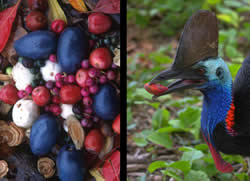 The majority of a Cassowary’s diet is made up of rainforest fruits, including the Blue Quandong and Davidson and Cassowary plums. Frugivorous animals (fruit eaters) play an important ecological role in the rainforest, dispersing the seeds of the fruits they consume.
The majority of a Cassowary’s diet is made up of rainforest fruits, including the Blue Quandong and Davidson and Cassowary plums. Frugivorous animals (fruit eaters) play an important ecological role in the rainforest, dispersing the seeds of the fruits they consume.
The Southern Cassowary is one of the most important seed dispersers in its tropical rainforest habitat, particularly of those fruits that are too large for other animals to consume, which makes it a ‘keystone species’.
Cassowaries have also adapted to food shortages associated with cyclones and other adverse weather events. They have learnt to eat other foods such as: plant leaf matter, fungi and carrion; insects and snails; and small animals such as lizards and rodents. Cassowary “poo” examinations have revealed whole bird and rodent skeletons and fish scales.
Find out more about the Cassowary’s amazing gut in this short video from Taronga Zoo
Want to learn more about these incredible birds?
Who am I? The Endangered Southern Cassowary
Ecology & Habitat – The Rainforest Gardener
Indigenous Cultural Significance
Roles of Zoos and Captive Management
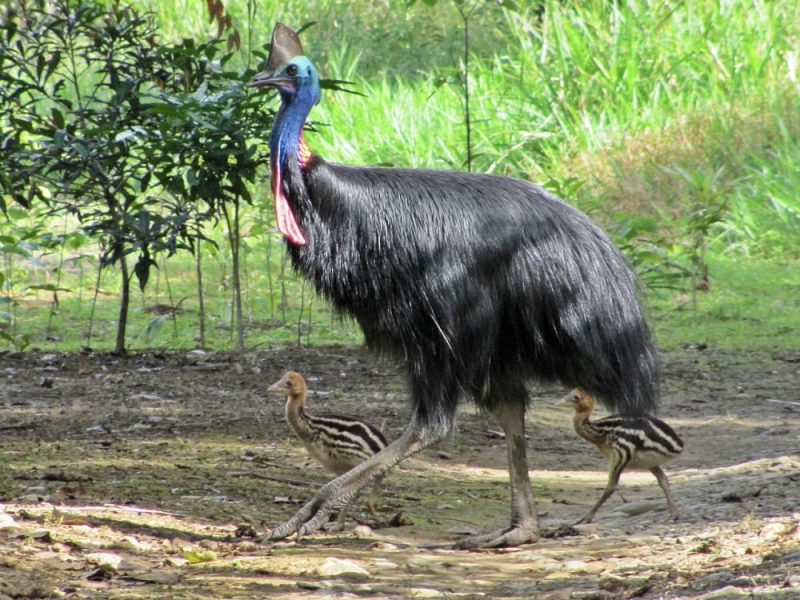

DONATE NOW
When you give generously, you become part of a committed team of individuals who collectively are helping to preserve some of the most biodiverse habitats and the species that live within them on this planet. Become a Rainforest Rescuer today!

